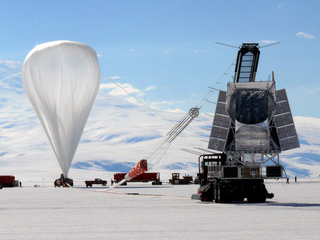BLAST

Stars form in the centres of dense clouds of gas and dust. The light emitted by stars in massive, young galaxies is predominatly at UV and optical wavelengths. This light, however, is heavily obscured by the surrounding dust, and star-forming galaxies are thus often quite faint at optical wavelengths. The inter-stellar dust is heated by the absorbed optical and UV light and reradiates thermally at far-infrared and submillimetre wavelenghts. The Balloon-borne Large Aperture Submillimeter Telescope (BLAST) is a telescope designed to detect these young star-forming galaxies in the early Universe by directly detecting warm dust. Since the atmosphere is opaque to infrared light, one must observe from outside of the Earth's atmosphere, hence a balloon-borne telescope.
BLAST makes use of relatively recent detector technology, a device known as a bolometer. A bolometer consists of an absorb, which is heated by incoming radiation, and a sensitive thermistor, which measures the change in heat in the absorber. A camera consisting of arrays of bolometers at 3 wavelengths, 250, 350 and 500 micron, was developed for the SPIRE instrument aboard the Herschel Space Observatory. The BLAST camera is based on the SPIRE design, and since a balloon-borne experiment can be built much more quickly than a satellite, BLAST was able to obtain data several years earlier than Herschel/SPIRE.
The BLAST team consists of about 20 people from about 10 institutions across North America and Europe, led by the University of Pennsylvania. BLAST has completed two scientific flights, the first a 5-day flight in June, 2005 from northern Sweden across the Altantic to northern Canada, and the second an 11-day flight in the December, 2006 from McMurdo Station, Antarctica. The UBC team was intimately involved with BLAST, from the design phase right through to the final publications. This includes the design of the gondola and active pointing system, construction, operation and low- and high-level analysis.
The extragalactic science resulting from the 2006 flight are described in some detail here, but briefly, based on deep and wide images of the GOODS-South field, we have for the first time:
- measured the galaxy number counts (number of galaxies as a function of galaxy brightness)
- resolved the extragalactic background into known sources
- measured directly the cosmic star formation history
- measured clustering of submillimetre sources via the angular power spectrum